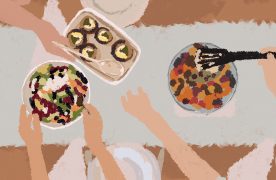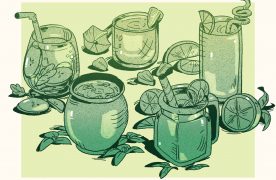Beauty rests at the heart of Japanese culture. Japanese calligraphy, flower arrangements and video games hold their aesthetics to a higher degree. And how could we forget cleanliness? Marie Kondo’s KonMari method, which encourages followers to embrace objects that bring them happiness and encourages clean, tidy lifestyles, grows in popularity with every passing month.
Marie, and more importantly my mom, got me thinking about the beauty of Japanese cuisine. If you didn’t know, this past Sunday was Hinamatsuri, or Girls’ Day. Girls’ Day is a Japanese holiday that celebrates, you guessed it, girls!
Back home, we celebrate the holiday with copious amounts of mochi and small gifts from close family members. In elementary school, the girls get to go to recess before the boys.
But back to my mom. Every month or so, my mom and other family members send me boxes filled with foods from home and other small whatsits that I can’t find in Boston. They’re usually themed. This month, my box burst with pink and Japanese treats, all neatly packed in a white cardboard box to celebrate Girls’ Day.
There, nestled against the box’s instant rice and ramen, was a sleeve of mochi wrapped in pretty wax packaging. When I opened the food, two perfect rows of plump, pink, chewy sweets stared back at me. I squished one with my pointer finger and appreciated the soft, forgiving texture that bounced back at me. The sign of good mochi.
The mochi in my box, like nearly all Japanese food, exemplifies the importance of beauty. After savoring one too many mochi on Sunday, I realized how much I miss good-looking food.
On top of enhancing the general dining experience, personable food holds other added benefits.
You know how 3-year-olds only try their vegetables when their food resembles a face on their plate or some other shape? Why does that change when we grow up? The truth is: it doesn’t.
When I visited Japan a couple of years ago, I had the pleasure of dining at the Rilakkuma Café in Tokyo. Each dish featured food that looked like Rilakkuma, a character created by San-X, a company that’s a lot like Sanrio.
As I chomped away at my cute Rilakkuma-shaped food, I checked out who my lunch peers were. Every last one was in their early 20s at least. If adults like food resembling cartoons, why don’t we eat like it more often?
I guess the easy answer is because of time constraints. I don’t have the patience, skill or schedule to make all my food look like Rilakkuma or anything like it really, but I do know the effort put into meal presentation is definitely doable on a regular basis.
I find myself making sure my pasta lays perfectly twirled in my bowl, even when I’m just eating by myself on a school night. I also compartmentalize my food. The rice balls in my lunch must be separated from the edamame container, which is separated from the dumplings stacked in threes next to the rice.
Why do you do all of this, you ask? For one, I’m more willing to finish my food, and, for another, it brings me joy. But the most important reason why I do it is that it reminds me of my home and mom. I will never be as professional as my mom, though. I still don’t understand how she managed to make sandwiches that looked like pumpkins for school lunch on Halloween.
The next time you make your lunch, try to make it a masterpiece, too. There’s more value in it than you think.











